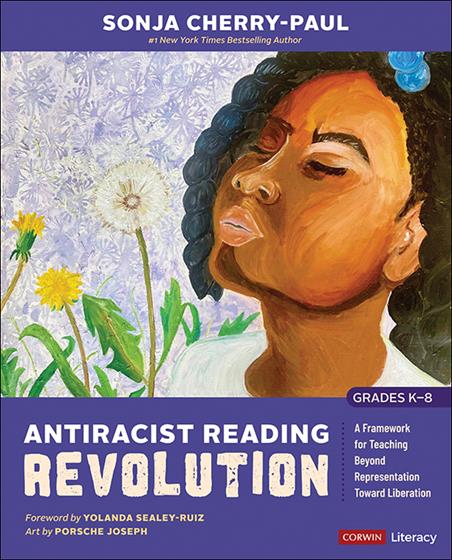Excerpted from Antiracist Reading Revolution: A Framework for Teaching Beyond Representation Toward Liberation by Sonja Cherry-Paul. Copyright (c) 2024 by Corwin Press, Inc. All rights reserved.
While there is no one way to define antiracist curriculum or instruction, several characteristics emerge from the existing and growing body of scholarship on antiracism. I have identified five that can inform instruction and shape the educational experiences of students. Each of these characteristics works together as a whole to construct a vision of an antiracist reading classroom—the work of teachers and the work of students—that leads to liberation.
Although I discuss each of the characteristics individually and one at a time, it is important to note that they are not linear, but circuitous and interconnected. Looking at them individually can, I hope, provide a greater understanding of antiracist teaching as lived, liberatory practice.
1. Center BIPOC in texts
 Antiracist educators work to affirm racially and culturally diverse people and communities lovingly and joyfully. One way to achieve this is through transparent, intentional text selection, understanding that otherwise, books and texts are powerful ways young people can be socialized into racist and inequitable ideas. In Stamped (For Kids): Racism, Antiracism, and You, I ask young readers to look out for mainstream representations that too often provide limited, deficit, harmful perspectives of Black and Brown people. Therefore, antiracist teaching seeks to powerfully reflect those who have been minoritized and marginalized in depth rather than in superficial breadth that can proliferate stereotypes. Books and texts written by BIPOC creators who share the same racial and cultural identity as the people and characters they are writing about are more likely to present important, nuanced perspectives.
Antiracist educators work to affirm racially and culturally diverse people and communities lovingly and joyfully. One way to achieve this is through transparent, intentional text selection, understanding that otherwise, books and texts are powerful ways young people can be socialized into racist and inequitable ideas. In Stamped (For Kids): Racism, Antiracism, and You, I ask young readers to look out for mainstream representations that too often provide limited, deficit, harmful perspectives of Black and Brown people. Therefore, antiracist teaching seeks to powerfully reflect those who have been minoritized and marginalized in depth rather than in superficial breadth that can proliferate stereotypes. Books and texts written by BIPOC creators who share the same racial and cultural identity as the people and characters they are writing about are more likely to present important, nuanced perspectives.
2. Recognize cultural, community and collective practices
Antiracist educators recognize the importance of truly knowing their students — their personal identities, such as favorite TV shows, movies, sports and music, and also their social identities, which include their racial, cultural and linguistic identities as well as knowing the communities in which they live. Antiracist educators see this work of knowing as continuous, and it helps them to develop instruction and curriculum that are closer fits between students’ home and school cultures. Kimberly Parker asserts, “We see the world through our own racialized, gendered, complicated lenses” and the importance of educators reframing our thinking. To accomplish this, she recommends we lean into the scholarship around “funds of knowledge” to develop multidimensional understandings of the children in teachers’ care. Therefore, antiracist teaching is grounded in historical and contemporary experiences and issues of people and community. Rather than revering individualism and competition, books and texts that are centered in curriculum support collectivism and communal practices and are those that value multiple ways of knowing across cultures.
3. Shatter silences around racism
Educators name racism proactively and explicitly and help students develop a working definition of racism. This definition deepens across space, time and context, making it possible for students to recognize social, economic and political factors that create environmental conditions that oppress BIPOC and communities. Each summer, Tricia Ebarvia and I co-facilitate the Institute for Racial Equity in Literacy (IREL), a unique professional development experience that supports educators in the work of antiracism and equity in their classrooms, schools and communities. This work demands critical reflection and action. We challenge educators to identify the ways in which racism has been embedded throughout history and in every societal institution, including schools.
